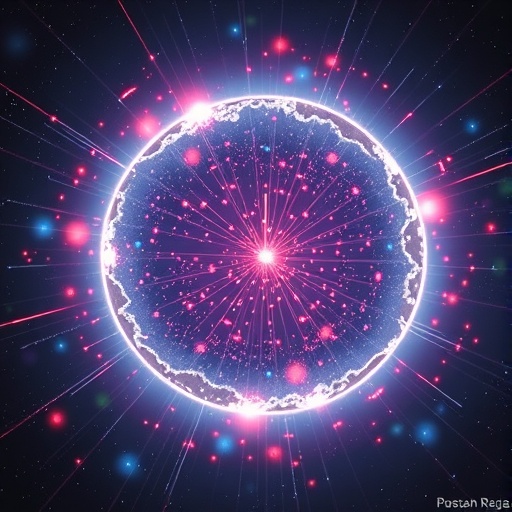An international research team has made groundbreaking advances in plasma physics, unveiling the first instance of plasma “fireballs” using the Super Proton Synchrotron accelerator located at CERN in Geneva. This pioneering experiment, led by scientists at the University of Oxford, aims to illuminate critical aspects of the stability of plasma jets that emerge from blazars, the highly energetic active galaxies with supermassive black holes at their centers. The findings, which were disclosed on November 3, have been documented in the esteemed Proceedings of the National Academy of Sciences (PNAS).
Blazars are noteworthy mechanisms in the universe; they are characterized by their ability to produce narrow jets of matter that travel at nearly the speed of light toward Earth. These jets emit intense gamma radiation, observable by ground-based telescopes, extending to energies reaching several teraelectronvolts (TeV). As high-energy gamma rays traverse the vast expanse of intergalactic space, they scatter against the faint background light emitted by stars. This interaction generates cascades of electron–positron pairs that should, theoretically, produce lower-energy gamma rays detectable by advanced space observatories like the Fermi satellite. Despite extensive monitoring, these GeV gamma rays have remained elusive, presenting a perplexing conundrum for astrophysicists.
The inability to detect these gamma rays has led to various theories, one of which posits that weak intergalactic magnetic fields may redirect the lower-energy gamma rays away from our observational line. Alternatively, another hypothesis rooted in the principles of plasma physics suggests that as the electron–positron pairs travel through the sparse matter between galaxies, they could undergo instability. This instability could amplify small fluctuations, generating magnetic fields that further disturb the beam and dissipate energy.
To evaluate these competing theories, the research group, which comprises experts from the University of Oxford and the Science and Technology Facilities Council’s Central Laser Facility (CLF), undertook a series of experiments. They utilized CERN’s High-Radiation to Materials (HiRadMat) facility to produce electron–positron pairs with high precision and introduced them into a controlled plasma environment. This setup served as a laboratory analogue for the cascading pair processes seen in blazar jets. Through meticulous measurements of the beam profile and the associated magnetic field signatures, the team sought to directly gauge whether beam-plasma instabilities would significantly disrupt the properties of the jet.
The results surprised the research team, as they found that the electron-positron pair beam maintained a remarkably stable and narrow profile, deviating very little or not at all from its intended trajectory. This observation significantly curtails the possibility that beam-plasma instabilities contribute to the apparent absence of GeV gamma rays. In extrapolating their laboratory findings to astronomical contexts, the team suggested that the intergalactic medium likely harbors a magnetic field that has its origins in the early universe.
Professor Gianluca Gregori, the lead researcher from the Department of Physics at the University of Oxford, articulated the significance of these findings. He emphasized how laboratory experiments can bridge theoretical predictions with observational data, enhancing our comprehension of celestial phenomena observed from both ground-based and satellite telescopes. His statement underlined the collaborative nature of this work, which underscores the vital role of international partnerships in traversing unexplored territories in high-energy physics.
However, the implications of this study extend beyond mere clarification of certain astrophysical mysteries. The early universe, understood to have been homogeneous and isotropic, presents additional questions about the genesis of antiquated magnetic fields. The research team hints at the possibility of new physics beyond the traditional Standard Model, indicating that future exploration could unveil further insight into the universe’s formative conditions.
Co-investigator Professor Bob Bingham from the STFC’s Central Laser Facility echoed the importance of their work, explaining how laboratory astrophysics can provide a unique testing ground for theories concerning the dynamics of high-energy cosmic phenomena. By simulating conditions similar to those found in cosmic jets, the experiments afford scientists the opportunity to quantify processes that potentially shape these jets’ evolution and elucidate the nature of magnetic fields in intergalactic locales.
Further contributions to this endeavor were made by Professor Subir Sarkar, also from the University of Oxford. He expressed enthusiasm for participating in such a cutting-edge experiment, underscoring that their striking findings invite broader interest in plasma astrophysics. By marrying high-energy laboratory physics with cosmic inquiries, the team hopes to unlock fundamental questions that have long eluded researchers.
This collaborative project brought together an impressive assembly of institutions and expertise, involving researchers from the University of Oxford, STFC’s Central Laser Facility, CERN, the University of Rochester’s Laboratory for Laser Energetics, AWE Aldermaston, Lawrence Livermore National Laboratory, the Max Planck Institute for Nuclear Physics, the University of Iceland, and Instituto Superior Técnico in Lisbon. This multifaceted approach highlights the global effort in addressing profound astrophysical questions with an array of perspectives.
In conclusion, the team’s groundbreaking findings not only chisel away at the obscurities surrounding the missing gamma rays associated with blazar jets but also challenge existing paradigms regarding cosmic magnetic fields. As the research unfolds, and with upcoming facilities like the Cherenkov Telescope Array Observatory poised to provide higher-resolution data, future experiments will likely drive deeper investigations into these critical astrophysical queries.
Subject of Research: Plasma fireballs and blazar jets
Article Title: Suppression of pair beam instabilities in a laboratory analogue of blazar pair cascades
News Publication Date: 3 November 2025
Web References: DOI: 10.1073/pnas.2513365122
References: Proceedings of the National Academy of Sciences (PNAS)
Image Credits: Gianluca Gregori
Keywords
Plasma physics, blazars, gamma rays, electron-positron pairs, high-energy astrophysics, cosmic magnetic fields, CERN, Super Proton Synchrotron, intergalactic medium.




